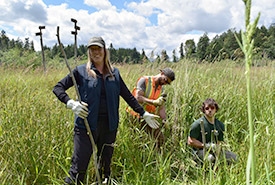Bioengineering with trees

The Wetlands Workforce crew installing live stakes at Chase Woods Nature Preserve (Photo by Cheyenne Bergenhenegouwen, BCWF Wetlands Workforce)
Live staking is perhaps the simplest form of soil bioengineering — the use of living plant materials to perform an engineering function, such as erosion control. Live staking is an old technique, dating back many centuries. It is also a fairly simple technique. Live cuttings are taken from trees (typically willow, balsam poplar, red-osier dogwood and elderberry species) and inserted into wet ground during the spring or fall. The stake sprouts roots and shoots that spread into the soil, binding unstable ground and preventing further erosion or slumping.
NCC’s Wetlands Workforce crew is preparing to use live staking this fall at the Chase Woods wetland restoration site. Here, the willow stakes will grow and not just stabilize the banks of this re-created wetland but will also help to out-compete the invasive reed canary grass that is a remnant of past agricultural activity here.
How to live stake: The stick-and-poke method
Step 1: Collect the stakes
Collect cuttings from a healthy parent plant. Cut branches that are about the width of your thumb and a metre in length. Collection is best in mid-fall or early spring when the plants are dormant. Be sure to collect cuttings before leaves begin to bud out in early March! This timing window gives the cuttings the best chance of establishing themselves in the ground with enough ample root growth.
Step 2: Plant the stakes
Using a steel staking bar, poke a long, deep hole into the ground for the cutting to be placed into. Insert the cutting into the soil so that at least ¾ of the length of the cutting is underground. Positioning the cutting upright is key to its survival — the stake won’t grow if it’s upside down! You will know you have it the right way if the buds on the cutting are pointing upward, so keep a few leaves of each cutting to know which way is up.
Step 3: Tend the stakes
Newly planted stakes will need moisture to help them establish roots. Depending on the time of year they are planted, the stakes may need extra watering. A spring-planted stake will need to be watered through the summer, but fall plantings can often get the moisture they need naturally.
Other live staking techniques
There are several other live staking techniques used in soil bioengineering, depending on the restoration goals of the site.
The wattle fence method lays live cuttings horizontal to the ground, and weaves cuttings in-between each other, creating a living retaining wall that is useful for vertical slopes, providing breaks in a steep slope.
Gravel bar staking is the use of living cuttings to provide a pioneering vegetation cover on the tops of streamside gravel bars that will help collect sediments as well as bind the gravel together with roots. This technique is useful where excess gravel is causing streamside instability.
The tripod method encourages the growth of over-hanging riparian vegetation designed to provide shade for newly constructed fish habitat. The cuttings are positioned into a tripod structure that is bound together at the top at a 45-degree angle. The canopy cover created by the newly emerged foliage will regulate water temperatures by providing shade.
Live staking is a useful tool in the development of effective restoration projects on difficult sites. It can help overcome challenges such as steep, unstable slopes that prevent natural recovery of drastically disturbed sites. This natural method for creating stability in a slope is a beneficial alternative to using hard and sometimes environmentally harmful engineering approaches such as concrete retaining walls. In addition to eliminating the need for “hard” materials when reclaiming a damaged site, established trees create habitat for wildlife, create oxygen and beautify the area.





